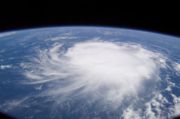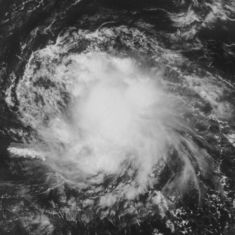Tropical Storm Chris (2006)
2007 Schools Wikipedia Selection. Related subjects: Storms
| Tropical storm ( SSHS) | ||
|---|---|---|
|
Tropical Storm Chris on August 2, 2006 |
||
| Formed | July 31, 2006 | |
| Dissipated | August 5, 2006 | |
| Highest winds |
|
|
| Lowest pressure | 1001 mbar ( hPa) | |
| Damage | Minimal | |
| Fatalities | None reported | |
| Areas affected |
Leeward Islands, Puerto Rico, Turks & Caicos Islands, Hispaniola, Bahamas, eastern Cuba | |
| Part of the 2006 Atlantic hurricane season |
||
Tropical Storm Chris was the third named storm of the 2006 Atlantic hurricane season. Forming on July 31 in the Atlantic Ocean east of the Leeward Islands, Chris moved generally to the west-northwest, skirting the northern fringes of the Caribbean islands. Chris was a relatively short-lived storm, reaching a peak intensity with winds at 65 mph (100 km/h) on August 2, while positioned north of St. Martin. The storm gradually weakened before finally dissipating on August 5, near eastern Cuba.
Overall impact was minimal, amounting to moderate amounts of rainfall throughout its path. Also, the affected areas were well prepared for the storm.
Storm history
On July 27, a westward-moving tropical wave was first observed about 550 miles (890 km) southwest of the Cape Verde Islands. Upper-level wind shear initially inhibited development, though the winds abated enough to allow convection to remain associated with the surface low pressure area. The wave steadily became more organized as upper level winds continued to become more favorable, though convection and shower activity remained minimal until late on July 31 when a circulation developed about 200 miles (320 km) east of the Leeward Islands.
Due to persistent deep convection near the circulation, the National Hurricane Centre upgraded the system to Tropical Depression Three late on July 31 while located 160 miles (260 km) east-southeast of Antigua. Forecasters initially predicted wind shear from an upper level low would prevent strengthening and cause dissipation in three days. However, the depression continued to organize as deep convection developed near the circulation, and the system intensified into Tropical Storm Chris early on August 1. The convection gradually consolidated over the strengthening, and by late on the 1st Chris reached winds of 60 mph (95 km/h) while passing 50 miles (80 km) north of the northern Leeward Islands. The structure of Chris continued to improve and become more symmetrical, and an upper level eye feature developed early on August 2. Outflow improved in all quadrants, as well, and the storm reached a peak intensity of 65 mph (100 km/h) shortly thereafter while located 120 miles (195 km) east of St. Thomas. Despite initial predictions of Chris intensifying to a hurricane as a ridge of high pressure forced it west-northwestward, upper level shear dissipated the well-defined inner core of the storm, and Chris started to weaken.
Early on August 3, strong wind sheer over Chris detached the deep convection from the low level circulation, while at the same time a building ridge to its north turned the storm towards the west. By mid-day on the 3rd the circulation was devoid of any convection within 85 miles (135 km), while the deeper convection spread across Puerto Rico and Hispaniola. Late on August 3, deep convection developed over the centre of circulation again, though persistent vertical shear weakened Chris to a tropical depression on August 4. Due to lesser amounts of shear as predicted by computer models, forecasters indicated the possibility moderate strengthening in the Gulf of Mexico to a 60 mph (95 km/h) storm. However, the National Hurricane Centre issued the last advisory on the system early on August 5, stating the system was degenerating into a broad area of low pressure while near the northeast coast of Cuba. Late on August 5, convection increased in the remnants of the storm, and forecasters indicated the potential for slow development over the Gulf of Mexico due to marginally favorable conditions. Redevelopment never occurred, and the remnants of Chris dissipated on August 6 over the southeastern Gulf of Mexico.
Preparations

When the National Hurricane Centre issued its first advisory on Tropical Depression Three, the governments of Antigua and Barbuda, Anguilla, Saint Kitts and Nevis, and the British Virgin Islands issued a Tropical Storm Warning for their respective territories. When the depression strengthened to Tropical Storm Chris, Tropical Storm Warnings were also issued for Saba, Sint Eustatius, Saint-Barthélemy, and Saint Martin. Three Royal Caribbean cruise ships re-routed their paths to avoid the storm. FEMA representatives coordinated with local emergency management officials in the United States Virgin Islands to determine if preparation necessities would be adequate, such as hospital usage, shelters, and sand bags. In St. Thomas, all jet flights were cancelled in and out of the island, though small airlines were permitted to fly during the storm. Ferry service from Saint Martin to Anguilla was cancelled for a short period of time. Saint Martin officials recommended citizens to secure all loose items, for coastal residents to prepare for high surf, and for construction sites to secure all loose equipment. A small craft advisory was also issued for coastal waters of Saint Martin due to strong waves from the storm.
On August 1, officials in Puerto Rico issued a tropical storm warning for the island. The next day, approximately 600 tourists evacuated the islands of Vieques and Culebra. Citizens in Puerto Rico prepared for the storm by stocking up on supplies and visiting gas stations.
On August 2, the government of the Bahamas issued a Hurricane Watch for the Turks and Caicos Islands, the Acklins and Crooked Islands, Ragged Island, Inagua, and Mayaguana. In response to the threat, officials urged citizens to stock up on hurricane supplies, while boat owners in Staniel Cay secured their boats in preparation for the storm.
In response to the storm's projected path into the Gulf of Mexico, prices for crude oil rose on the New York Mercantile Exchange at branch offices in London. Natural gas prices rose considerably in New York Mercantile Exchange electronic trading on August 2. Anticipation of a threat to supply by a potential Hurricane Chris coupled with high demand during an ongoing heat wave were cited as factors in the price move. In New Orleans, officials including Mayor Ray Nagin prepared for a possible evacuation of the city if Chris entered the Gulf of Mexico as a hurricane. The evacuation plan included moving all residents out of the city as a worst-case scenario, intended to avoid a re-occurrence of Hurricane Katrina around 1 year prior. Florida Emergency Management requested 10 mobile recovery centers, and placed hospitals in the Florida Keys on standby for evacuation. Officials in Mississippi identified the need for 110 to assist in an evacuation process in case of a possible landfall. Both Louisiana and Texas emergency operation centers monitored the progress of the storm, though didn't execute any preparation action.
Impact
Damage caused by Tropical Storm Chris was minor and generally confined to local flooding.
St. Thomas received brief amounts of heavy rain, with totals of over 3 inches (75 mm). Anguilla reported light rain and wind gusts of up to 21 mph (34 km/h). In St. John the storm caused peak wind gusts of 23 mph (37 km/h)and along with moderately heavy rainfall of nearly 3 inches (75 mm), along with reports of lightning near the storm's centre. Though impact was minimal in Saint Martin, Governor Franklyn Richards recognized the storm preparations served as a wake up call for citizens who weren't ready for the hurricane season. In San Juan, Puerto Rico, the storm caused very little wind or rain. Convection dissociated from the centre of the storm produced 30 mph (48 km/h) wind gusts and over 1.3 inches (33 mm) of rain in Culebra. Rainfall from the storm caused the Fajardo River to overflow its banks. The overflown waters temporarily closed a highway in the northeastern portion of the island.
Rainfall reached up to 2 inches (50 mm) across portions of Hispaniola, the Turks and Caicos, the Bahamas, and eastern Cuba, and reached 4 inches (100 mm) in some mountainous areas. In Santo Domingo in the Dominican Republic, heavy rainfall caused severe flooding. Several people were left temporarily homeless due to flooding entering their households. The flooding left many roads impassable near the capital city, and also resulted in landslides. The flooding also covered rice fields in the northeastern portion of the country. The National Office of Meteorology issued flood warnings for residents in low-lying areas and near rivers in the northeast and southeast portions of the country. Despite the flooding, overall damage was minor, and there are no casualties associated with Chris.

